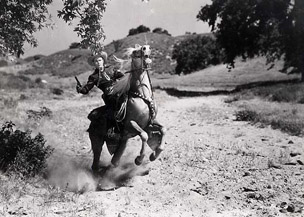Classic Movie Review: Under Western Stars
By Jason Barney
August 11, 2014
Sometimes an old film can be a pleasant surprise. Roy Rogers’ first significant movie, Under Western Stars, is campy and Rogers comes across as a nerdy boy scout. However, even though it was made way back in the 1930s, it offers pinpoint social commentary that still applies today. The plot, setting, and events are very powerful to the aware viewer.
It goes without saying that special circumstances must arise for one to want to watch a movie like this. Perhaps an older family member is lonely, or maybe one wishes to explore westerns in general. The black and white flick belongs within the subgenre of the “singing” western. There aren’t any special effects, which places it in a different era of moviemaking. Under Western Stars is to cinema as the Model T is to car fans. It comes from an age few people remember. That is part of its charm.
As the film begins, one awaits typical old west features. Viewers expect 19th Century Indian tribes roaming the land, railroads snaking across the continent, and gold and silver mines in operation. What they get is much different. Even for its time, it is a “modern” western. It is 1938 and the Dust Bowl has much of the western U.S. in its grip. The landscape is barren and parched. Hometown folks cannot maintain their farms or quality of life. Under Western Stars provides great social commentary about the Great Depression.
The film begins with a nice action sequence. Area landowners and ranchers are moving against a powerful water company that owns a massive dam on a large river. They subdue the guards and company employees, take control of the dam, and allow water to reach their dying crops and animals. It is comical… and nobody dies in the opening gun fight. Roy Rogers shows up to support the locals, leaping from galloping horses and tackling the nameless guards of the no good water company. With the altercation over, the scene shifts to the local town.
Since he is such a likable guy, and his father was at one point was involved in politics, Rogers is encouraged to run for Congress. At first the idea seems foreign to him, and he displays a classic amount of likable humility. When the local judge lets him off the hook for siding with the locals, Rogers enters the political arena. His campaign is as small town and neighborly as apple pie. His candidacy allows him to sing songs about the current state of political affairs, which fits nicely into the story. His campaign is simple and lighthearted, and rather than delve deeply into any issues, it just scratches the surface. Rogers and his cowboy hat campaign work, especially with gimmicks like hanging political signs on the sides of cattle. Mr. Fairbanks, the wealthy owner of the dam, plots and schemes against the hometown hero.
Rogers obviously wins, and heads to Washington, D.C. No other issues are on his docket except the lack of water back home. The nature of politics and wheeling and dealing are explored when the new representative learns he must grab the attention of Congressman Marlo, whose support is critical. Greedy and not too concerned with the plight of the average man, the wealthy Mr. Fairbanks works against Rogers’ efforts. During an important scene, Rogers gives a video presentation about the severity of the drought and Fairbanks reveals that some of the footage was not from Rogers’ home area. In an honest defense of his methods, and as part of the charm of this story, we learn his old stomping grounds are so remote no filming has ever happened there.
Rogers becomes desperate when Congressmen Marlo, tainted by the villain’s meddling, fails to grasp the extent of the situation. He calls upon local landowners and ranchers to reveal how desperate everyone is. Even for something produced in 1938, the scenes exposing the Dust Bowl are very convincing. Blowing dirt and sand squeeze through slightly open doors. Once fertile land is dead and gray, like a graveyard. The final confrontation at the end is a bit silly, and does not fit well with the lightheartedness of Rogers’ character or style of the movie, but this is a minor complaint.
Under Western Stars provides some pretty good entertainment and is viewable as a historical tool. Movie fans can sample a singing western and be entertained by political themes sadly alive and well in the present. Mr. Fairbanks, the wealthy dam owner, can easily be associated with the concerns about corporate greed. The political attitudes are more tolerable than the gridlock Washington can’t seem to let go of each day. And the backdrop of Under Western Stars, featuring the ravages of the Dust Bowl and drought, really strikes home when stories about the dire situation in present day California are in the news. That state is going through its worst dry spell in recorded history, with many water reservoirs at less than 50% capacity. It’s striking how events are so similar almost 70 years after the film was made. Black and white story telling may have been left behind, but the issues seem strangely familiar.
Over the years, Under Western Stars has picked up an accolade or two. After it was released, the song “Dust” was nominated for an Academy award. In 2009, the classic was selected for the National Film Registry by the Library of Congress for being an important icon in American film history. Such a designation preserves the original work, allowing it to stand above countless other movies.
All in all, Under Western Stars is quite enjoyable. They just don’t make films like this anymore.




